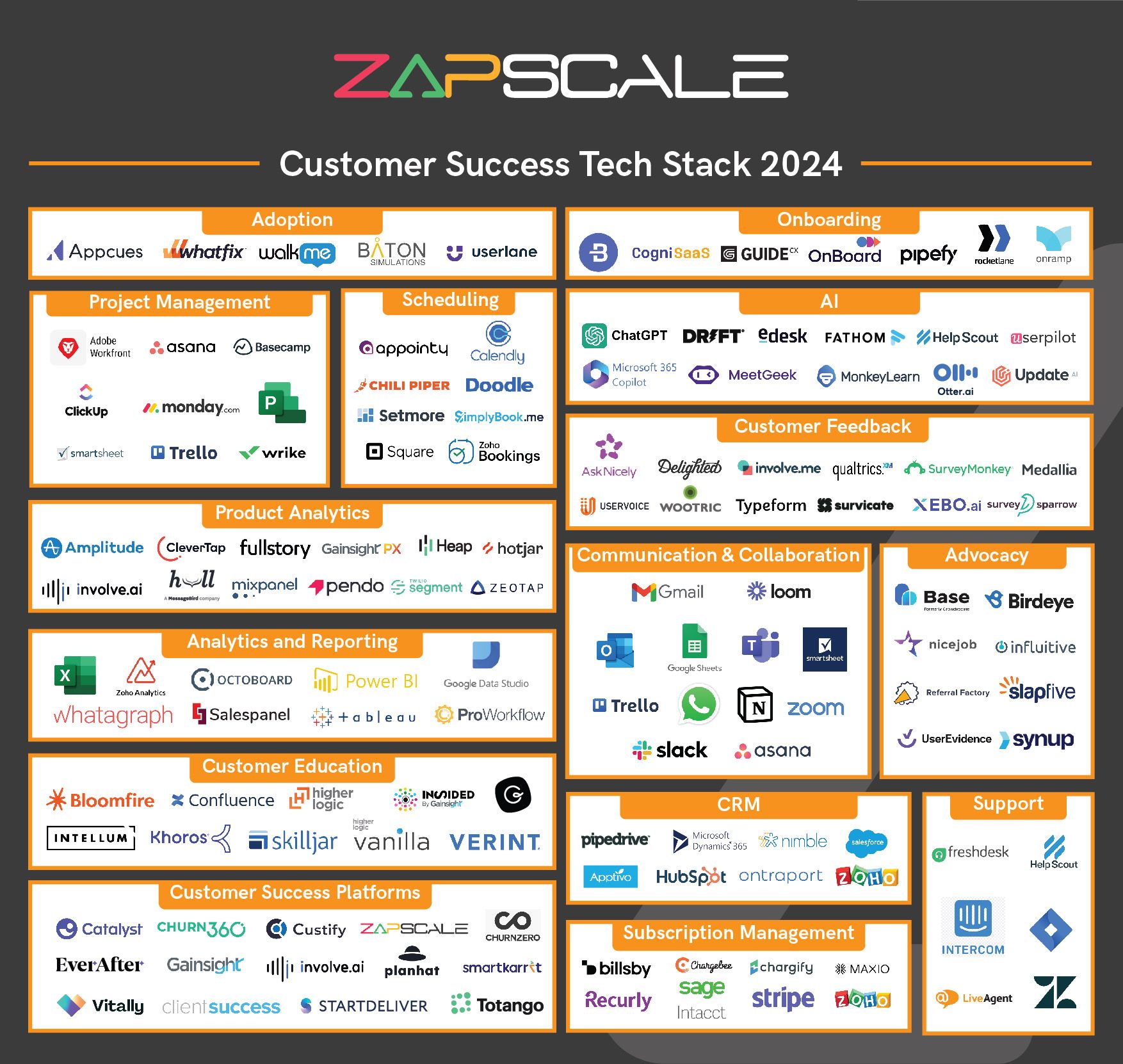CATEGORY > Customer Success Management
The Ultimate Customer Success Tech Stack for 2025

There’s no doubt that Customer Success plays a big role in the sustainable growth of a business, especially in the world of SaaS.
However, keeping customers happy and engaged isn’t an easy task, especially when you’re dealing with a big customer portfolio. Customer success is much more than just tracking customer happiness and relationship building.
Introduction
In the digital era, where we’re surrounded by tech-driven products to make our tasks simpler, a robust technology stack can prove to be a vital toolkit for your customer success team. Having the right technology can help you build strong customer relationships, anticipate customer issues, and ensure customers achieve their goals with a desirable experience.
Why you must have a robust Customer Success Tech Stack?
Here is why a robust customer success tech stack matters to you in 2025 more than ever:
1. Proactive Engagement
No one likes playing catch-up or firefighting with customer issues. A good tech stack can equip you with early warning systems. It helps you identify potential roadblocks before they become roadblocks, allowing you to proactively reach out, offer guidance, and prevent frustration.

2. Personalized Interactions
Your customers aren't just numbers in a system; they're individuals with unique needs and goals. A smart tech stack helps you break away from a one-size-fits-all approach. It gathers data on individual behavior, preferences, and product usage patterns, enabling you to personalize your communication and support.
3. Seamless Communication
I’d choose the latter any day!
With a seamless communication mechanism, your customers can reach you through their preferred channels – chat, email, phone, slack, etc – and your team can respond quickly and efficiently, with all context at their fingertips.
4. Increased Productivity and Efficiency
Repetitive tasks like customer onboarding, data entry, and basic troubleshooting can bog down your team. AI-powered tools and automation capabilities within your tech stack can handle these tasks, freeing up your team's time and energy for high-touch interactions and strategic initiatives.
5. Continuous Improvement
Your business isn't static, and neither should your tech stack. Choose tools that are adaptable, constantly evolving, and ready to integrate with new technologies. This ensures you can navigate changing customer needs, industry trends, and emerging opportunities.
We’ve prepared a comprehensive customer success tech stack for your customer success team, have a look.

You can also download the Customer Success Tech Stack as a PDF, by clicking the button below:
3 Things to Consider When Selecting Tools for a Customer Success Tech Stack
A well-curated customer success tech stack is instrumental in delivering exceptional customer experiences and driving business growth. However, with a plethora of tools available, selecting the right ones can be overwhelming. This article outlines essential considerations when building your customer success tech stack.
1. Understanding Your Customer Success Goals
Before diving into tool selection, it's crucial to define your customer success goals clearly. This involves:
- Identifying key metrics: Determine the metrics that will measure your team's success (e.g., customer retention, NPS, customer lifetime value).
- Defining customer journey stages: Map out the customer lifecycle to understand touchpoints and needs at each stage.
- Identifying pain points: Analyze current challenges and processes to identify areas where technology can improve efficiency.
2. Core Functionalities to Consider
Your tech stack should encompass tools that support the following core functions:
- Customer Relationship Management (CRM): A central repository for customer information, including contact details, purchase history, and interactions.
- Customer Success Platform: Provides a holistic view of customer health, automates tasks, and offers insights for proactive customer engagement.

- Communication Tools: Facilitates efficient communication with customers (e.g., email, live chat, phone).
- Knowledge Base: Offers self-service options and empowers customers to find solutions independently.
- Product Adoption Tools: Tracks product usage and identifies areas for improvement in customer onboarding and training.
- Customer Feedback Tools: Collects and analyzes customer feedback to inform product development and customer experience enhancements.
- Analytics and Reporting Tools: Provides insights into customer behavior, performance metrics, and trends.
3. Essential Evaluation Criteria
When selecting tools, consider the following criteria:
- Integration Capabilities: Ensure seamless integration with your existing tech stack to avoid data silos and streamline workflows.
- Scalability: Choose tools that can accommodate your business's growth and evolving needs.
- User Friendliness: Opt for tools with intuitive interfaces that are easy for your team to adopt and use.
- Data Security and Privacy: Prioritize tools that adhere to strict data protection standards.
- Cost-Benefit Analysis: Evaluate the return on investment for each tool and prioritize based on budget constraints.
- Vendor Support: Consider the quality of customer support provided by the tool vendor.
A well-chosen and utilized technology stack isn't just about technology; it's important to select the right customer success tools for your needs. It's about investing in your customers' success. It's the difference between a bumpy, frustrating journey and a smooth, delightful path to achieving their goals.
Frequently Asked Questions (FAQs)
1. How do I choose the right customer success tools for my business?
Selecting the right tools depends on your specific business needs, customer base, and budget. Consider factors like scalability, integration capabilities, user-friendliness, and the tool's alignment with your customer success goals. It's often helpful to start by mapping out your customer journey and identifying pain points.
2. What is the most important tool in a customer success tech stack?
While there's no one-size-fits-all answer, a Customer Success Platform (CSP) is often considered the cornerstone of a successful tech stack. It provides a centralized view of customer data, automates tasks, and offers insights to drive proactive customer engagement. However, other tools like CRM, communication platforms, and analytics tools are equally essential for a comprehensive approach.
3. How often should I re-evaluate my customer success tech stack?
It's recommended to review your tech stack at least annually to ensure it aligns with your evolving business goals and customer needs. Additionally, consider conducting more frequent assessments when introducing new products or services, experiencing significant customer growth, or facing challenges in customer retention.
ABOUT THE AUTHOR
Popular from Customer Success Management
Quality Content,
Straight To Your Inbox!
Subscribe for the latest blogs, podcasts, webinars, and events!

Write a Blog
If you have experience in CS and
a flair for writing, we’d love to
feature you.
Write to us on
hello@zapscale.com





